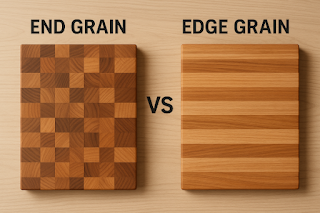End Grain vs Edge Grain Cutting Boards: Which One Fits Your Kitchen Best?
If you enjoy cooking, you've likely considered upgrading your cutting board. Among the many options, end grain and edge grain wooden boards are considered top-tier choices. But which one is right for your kitchen? In this post, we’ll compare the two types in terms of structure, durability, care, and aesthetics to help you make an informed decision.
What is an End Grain Cutting Board?
An end grain board is made by arranging the wood so that the cut ends (the grain) face upward. This means your knife slides between the wood fibers, reducing blade wear and allowing the board to "self-heal" from cuts. This structure is why professional chefs often prefer end grain boards—they're knife-friendly and durable.
What is an Edge Grain Cutting Board?
Edge grain boards are made by slicing wood along the length of the grain and arranging the strips so the long edges form the surface. These boards are simpler to manufacture and more affordable, making them a common choice for everyday home use. They’re harder than end grain boards and offer a clean, practical look.
Core Comparison Chart
- Blade Protection: End Grain > Edge Grain
- Durability: End Grain > Edge Grain
- Price: Edge Grain < End Grain
- Ease of Maintenance: Edge Grain < End Grain
- Design Variety: End Grain > Edge Grain
Recommendations Based on Cooking Style
1. If you cook often and value your knives:
→ Go for an end grain board. It preserves knife edges and offers excellent longevity.
2. If you cook occasionally and want something easy to maintain:
→ Choose an edge grain board. It’s easier to care for and more budget-friendly.
Maintenance Differences
End Grain: Requires oiling every 1–2 weeks, sensitive to moisture, should be dried immediately.
Edge Grain: Less sensitive, monthly oiling is usually enough.
Store boards vertically to prevent warping.
The Aesthetic Factor: Function Meets Style
End grain boards often showcase stunning, checkered patterns due to the exposed grain ends. Edge grain boards, on the other hand, offer a clean, striped look. Choosing based on your kitchen interior can be just as important as functionality.
Conclusion: Which Board is Right for You?
Ultimately, the choice depends on how often and how precisely you cook. If you care about knife longevity and want a visually stunning, durable board, go for end grain. If you want something reliable and easy to maintain, an edge grain board is a great pick. Either way, a quality wooden board can elevate both your cooking experience and kitchen aesthetic.
